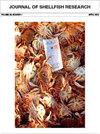Hypoxia and Anoxia Tolerance in Diploid and Triploid Eastern Oysters at High Temperature
IF 1
4区 农林科学
Q3 FISHERIES
引用次数: 1
Abstract
ABSTRACT Increasing reliance on the use of triploid oysters to support aquaculture production relies on their generally superior growth rate and meat quality over that of diploid oysters. Reports of elevated triploid mortality have generated questions about potential trade-offs between growth and tolerance to environmental stressors. These questions are particularly relevant as climate change, coastal activities, and river management impact water salinity, temperature, nutrients, pH, and oxygen levels within key estuarine oyster growing areas. In particular, the co-occurrence of warm water temperatures and low dissolved oxygen concentration (DO) events are increasingly reported in estuaries, with potentially lethal impacts on sessile, oyster resources. To investigate potential differences in DO tolerance, diploid and triploid market-sized or seed oysters were exposed to continuous normoxia (DO > 5.0 mg L–1), hypoxia (DO < 2.0 mg L–1), and anoxia (DO < 0.5 mg L–1) at 28°C and their mortalities were monitored. The hemolymph of the market-sized oysters was collected to measure cellular and biochemical changes in response to hypoxia and anoxia, whereas their valve movements were also measured. In general, about half of market-sized oysters died within about 1 wk under anoxia (LT50: 5.7–8.9 days) and within about 2 wk under hypoxia (LT50: 11.9–19.4 days) with diploid oysters tending to die faster than triploid oysters. Seed oysters took longer to die than market-sized oysters under both anoxia (LT50: 9.5–12.1 days) and hypoxia (LT50: 21.8–25.0 days) with diploid oysters (LT50: 9.5–11.8 days) dying slightly faster than triploid oysters (LT50: 11.8–12.1 days) under anoxia. Hemolymph pH decreased and plasma calcium and glutathione concentrations increased with decreasing DO, with values under anoxia being different than those under normoxia. Hemocyte density was also lower under anoxia than under either normoxia or hypoxia. Overall, few differences in physiological responses to hypoxia and anoxia were found between diploid and triploid oysters suggesting that ploidy (2N versus 3N) had limited effect on the tolerance and response of eastern oysters to low DO.高温条件下二倍体和三倍体东方牡蛎的缺氧耐受性
摘要越来越多地依赖三倍体牡蛎来支持水产养殖生产,这取决于它们通常比二倍体牡蛎更高的生长速度和肉质。三倍体死亡率升高的报告引发了关于生长和对环境压力的耐受性之间潜在权衡的问题。这些问题尤其相关,因为气候变化、沿海活动和河流管理会影响关键河口牡蛎种植区的水盐度、温度、营养物质、pH值和氧气水平。特别是,在河口,越来越多的报告称,温暖的水温和低溶解氧浓度(DO)事件同时发生,对固着的牡蛎资源造成潜在的致命影响。为了研究DO耐受性的潜在差异,在28°C下,将二倍体和三倍体市场大小或种子牡蛎暴露于持续常氧(DO>5.0 mg L–1)、缺氧(DO<2.0 mg L–2)和缺氧(DO<0.5 mg L–3)中,并监测其死亡率。收集市场大小的牡蛎的血淋巴,以测量它们对缺氧和缺氧反应的细胞和生化变化,同时还测量它们的瓣膜运动。一般来说,大约一半的市场大小的牡蛎在缺氧条件下(LT50:5.7-8.9天)在大约1周内死亡,在缺氧条件下约2周内(LT50:11.9-19.4天)死亡,二倍体牡蛎的死亡速度往往比三倍体牡蛎快。种子牡蛎在缺氧(LT50:9.5–12.1天)和缺氧(LT50/21.8–25.0天)下的死亡时间都比市场大小的牡蛎长,二倍体牡蛎(LT50:9.5-11.8天)在缺氧下的死亡速度略快于三倍体牡蛎(LT50/11.8-12.1天)。血淋巴pH值降低,血浆钙和谷胱甘肽浓度随着DO的降低而升高,缺氧条件下的值与常氧条件下的不同。缺氧时血细胞密度也低于常氧或缺氧时。总体而言,二倍体和三倍体牡蛎对缺氧和缺氧的生理反应几乎没有差异,这表明倍性(2N与3N)对东部牡蛎对低DO的耐受和反应影响有限。
本文章由计算机程序翻译,如有差异,请以英文原文为准。
求助全文
约1分钟内获得全文
求助全文
来源期刊

Journal of Shellfish Research
生物-海洋与淡水生物学
CiteScore
2.30
自引率
0.00%
发文量
40
审稿时长
6 months
期刊介绍:
Original articles dealing with all aspects of shellfish research will be considered for publication. Manuscripts will be judged by the editors or other competent reviewers, or both, on the basis of originality, content, merit, clarity of presentation, and interpretations.
 求助内容:
求助内容: 应助结果提醒方式:
应助结果提醒方式:


